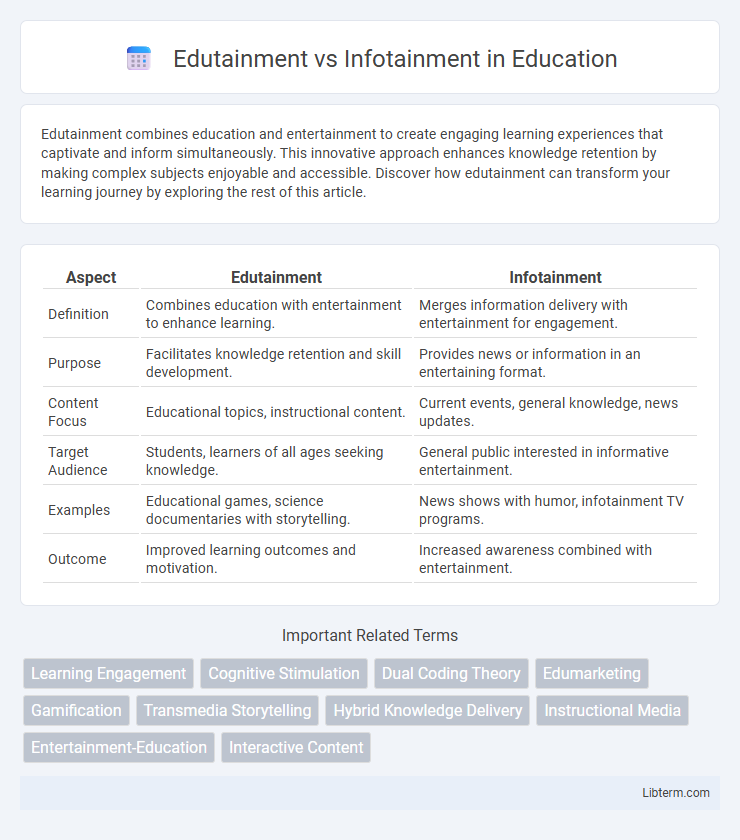Edutainment combines education and entertainment to create engaging learning experiences that captivate and inform simultaneously. This innovative approach enhances knowledge retention by making complex subjects enjoyable and accessible. Discover how edutainment can transform your learning journey by exploring the rest of this article.
Table of Comparison
| Aspect | Edutainment | Infotainment |
|---|---|---|
| Definition | Combines education with entertainment to enhance learning. | Merges information delivery with entertainment for engagement. |
| Purpose | Facilitates knowledge retention and skill development. | Provides news or information in an entertaining format. |
| Content Focus | Educational topics, instructional content. | Current events, general knowledge, news updates. |
| Target Audience | Students, learners of all ages seeking knowledge. | General public interested in informative entertainment. |
| Examples | Educational games, science documentaries with storytelling. | News shows with humor, infotainment TV programs. |
| Outcome | Improved learning outcomes and motivation. | Increased awareness combined with entertainment. |
Understanding Edutainment: Definition and Purpose
Edutainment combines education and entertainment to make learning engaging and enjoyable, often through interactive multimedia, games, or storytelling. Its primary purpose is to enhance knowledge retention and motivation by delivering educational content in an entertaining format. This approach is widely used in educational software, museums, and children's programming to foster both learning and enjoyment simultaneously.
What Is Infotainment? Key Characteristics
Infotainment combines information and entertainment, aiming to present news and educational content in an engaging, easily digestible format. Key characteristics include simplified language, visually appealing graphics, and a focus on storytelling to maintain audience interest. It often blends factual content with entertainment elements to enhance viewer retention and accessibility.
Core Differences Between Edutainment and Infotainment
Edutainment integrates educational content with entertainment to enhance learning outcomes, targeting cognitive development and skill acquisition. Infotainment primarily focuses on delivering information in an engaging, entertaining format, often prioritizing audience attention over depth of knowledge. The core difference lies in edutainment's intent to educate actively, while infotainment aims to inform passively through appealing content.
Historical Evolution: Edutainment vs. Infotainment
Edutainment originated in the mid-20th century, blending education with entertainment to enhance learning through media such as educational television programs and interactive exhibits. Infotainment emerged later, primarily in the 1980s and 1990s, combining information delivery with entertainment to attract broader audiences via news magazines and infotainment TV shows. Both evolved with technological advances, shaping how audiences consume educational content, with edutainment prioritizing learning outcomes and infotainment focusing more on engagement and mass appeal.
Popular Examples in Media and Technology
Edutainment platforms like Khan Academy and Sesame Street combine educational content with engaging media formats to enhance learning experiences for children and adults alike. Infotainment outlets such as CNN's "Reliable Sources" and BuzzFeed News blend information delivery with entertainment elements, prioritizing audience engagement in news consumption. Both media types leverage technology, including streaming services and interactive apps, to deliver content that balances knowledge dissemination with viewer retention.
Impact on Learning and Audience Engagement
Edutainment blends educational content with engaging entertainment techniques, significantly enhancing knowledge retention and learner motivation by making complex subjects accessible and enjoyable. Infotainment combines information dissemination with entertainment elements, aiming to captivate broad audiences but may sometimes prioritize engagement over depth, potentially limiting critical understanding. Both formats impact audience engagement differently; edutainment drives active learning and long-term comprehension, while infotainment boosts immediate attention but risks superficial absorption of information.
Benefits and Drawbacks of Edutainment
Edutainment combines education and entertainment to enhance learning engagement, improve retention rates, and make complex topics more accessible through interactive content and multimedia tools. Its benefits include fostering motivation and creativity, but drawbacks involve the risk of oversimplifying information and potential distractions that hinder deep understanding. Balancing entertainment with educational value is essential to maximize the effectiveness of edutainment in diverse learning environments.
Advantages and Pitfalls of Infotainment
Infotainment combines information and entertainment to capture audience attention, making complex topics more accessible and engaging, which can enhance knowledge retention. However, the blend often prioritizes entertainment value, leading to oversimplification or sensationalism that compromises accuracy and depth. Audiences may develop misconceptions or ignorance about critical issues due to biased or incomplete coverage inherent in infotainment formats.
Future Trends in Edutainment and Infotainment
Future trends in edutainment leverage immersive technologies like virtual reality (VR) and augmented reality (AR) to enhance interactive learning experiences, promoting better engagement and retention. Infotainment is evolving through AI-driven personalized content and real-time data analytics, delivering tailored news and entertainment that adapt to user preferences. Both sectors are increasingly integrating gamification and adaptive learning systems, transforming how audiences consume educational and informational content in digital environments.
Choosing the Right Approach for Your Content Strategy
Selecting between edutainment and infotainment hinges on your content strategy goals and audience preferences; edutainment blends education with entertainment to deepen understanding, while infotainment focuses on delivering news or information in an engaging manner. Content creators targeting knowledge retention and skill development will benefit from edutainment, especially in sectors like e-learning and training. For brands aiming to capture attention quickly and maintain high viewer engagement, particularly in media and marketing, infotainment is a more effective choice.
Edutainment Infographic

 libterm.com
libterm.com